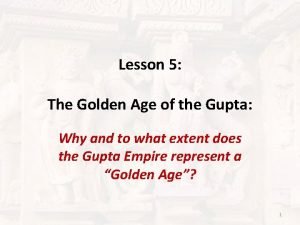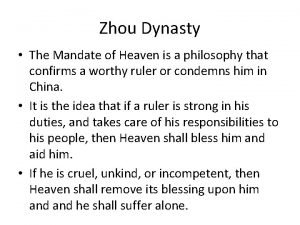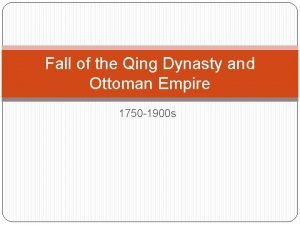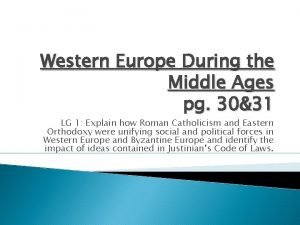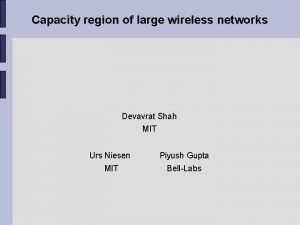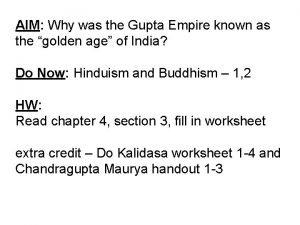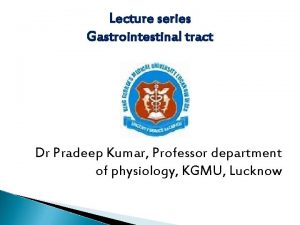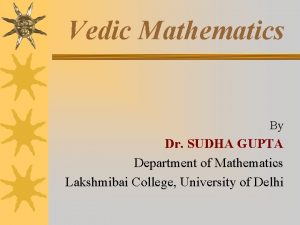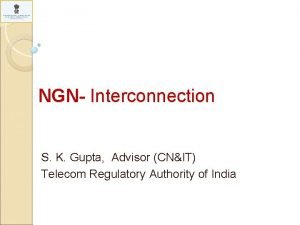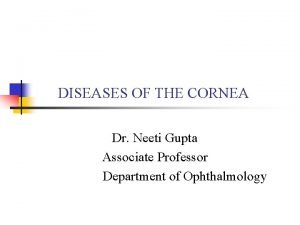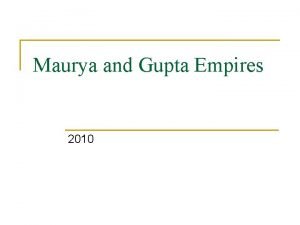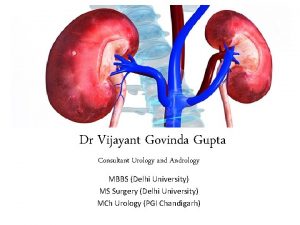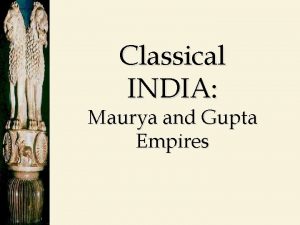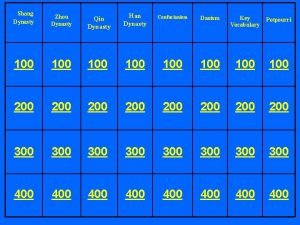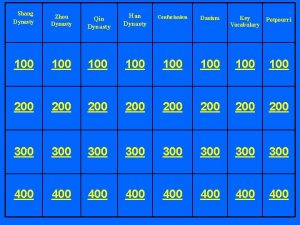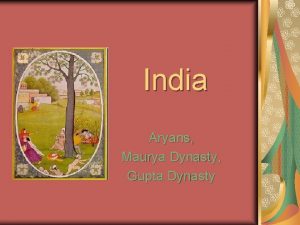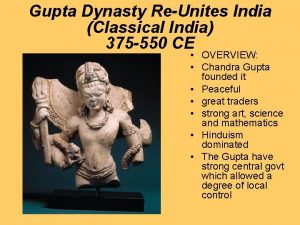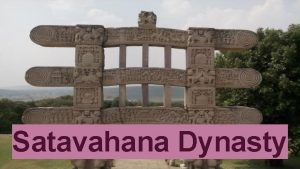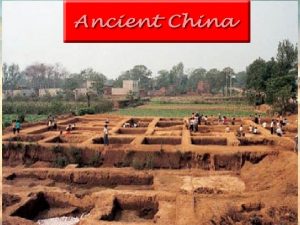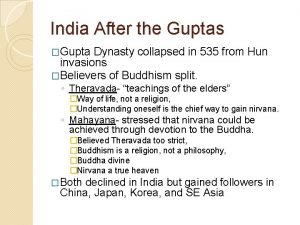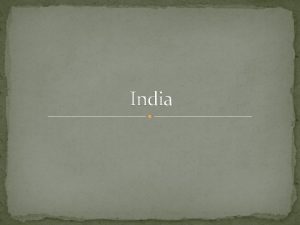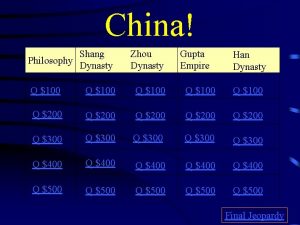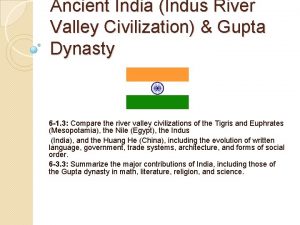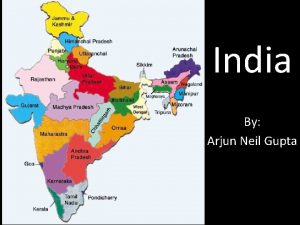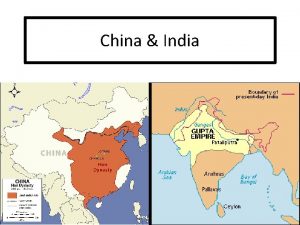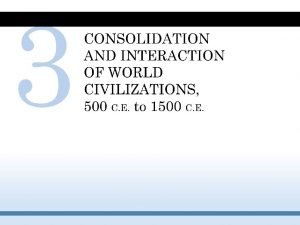India after the Fall of The Gupta Dynasty

































- Slides: 33


India after the Fall of The Gupta Dynasty • Invasion of White Huns from Central Asia beginning 451 CE • Gupta State collapsed mid-6 th c. • Chaos in northern India – Local power struggles – Invasions of Turkish nomads, absorbed into Indian society

King Harsha (r. 606 -648 CE) • Temporary restoration of unified rule in north India • Religiously tolerant – Buddhist by faith • Generous support for poor • Patron of the arts – Wrote three plays • Assassinated, no successor able to retain control

Harsha's empire at its greatest extent.

Introduction of Islam to Northern India • Arabs conquer Sind (north-west India), 711 • Sind stood at the fringe of the Islamic world • Heterodox population, but held by Abbasid dynasty to 1258

Merchants and Islam • Arabic trade with India predates Islam • Dominated trade between India and the west to 15 th century • Established local communities in India – Port city of Cambay

Mahmud of Ghazni • Leader of the Turks in Afghanistan • Raids into India, 10011027 • Plunders, destroys Hindu and Buddhist temples – Often builds mosques atop ruins

The Sultanate of Delhi • • Consolidation of Mahmud’s raiding territory Capital: Delhi Ruled northern India 1206 -1526 Weak administrative structure – Reliance on cooperation of Hindu kings • 19 out of 35 Sultans assassinated

Historical map of the Delhi sultanate

Hindu Kingdoms of Southern India Major states of Postclassical • Chola Kingdom, 850 -1267 India 600 -1600 CE – Maritime power – Not highly centralized • Kingdom of Vijayanagar – Mid-fourteenth century 1565 – Northern Deccan – Originally supported by Sultanate of Delhi – Leaders renounce Islam in 1336 – Yet maintain relations with Sultantate

Agriculture in the Monsoon World • Spring/summer: rains, wind from southwest • Fall/winter: dry season, wind from northeast • Seasonal irrigation crucial to avoid drought, famine – Especially southern India • Massive construction of reservoirs, canals, tunnels

The trading world of the Indian Ocean basin, 600 -1600 CE

Population Growth in India

Trade and Economic Development in Southern India • Indian regional economies largely selfsufficient • Certain products traded throughout subcontinent – Iron, copper, salt, pepper • Southern India profits from political instability in north

Temples and Indian Society • More than religious centers • Center of coordination of irrigation, other agricultural work – Some Temples had large landholdings • Education providers • Banking services

Cross-Cultural Trade in the Indian Ocean Basin • Trade increases in post-classical period • Larger ships – Dhows, junks • Improved organization of agricultural efforts • Establishment of Emporia – Cosmopolitan port cities serve as warehouses for trade • Specialized products developed (cotton, high-carbon steel)

The Kingdom of Axum • Example of trade-driven development • Founded in the highlands of northern Ethiopia about 1 st c. CE – Adopted Christianity • Displaces Kush as Egyptian link to the south – Axum destroys Kushan capital Meroë c. 360 CE – Major territorial expansion to late 6 th c.

The Kingdom of Axum (Aksum)

Obelisk at Axum Stone obelisk towers served to mark graves or represent a magnificent building.

Challenges to Caste and Society • • Migrations Growth of Islam Urbanization Economic development – Development of Jati (subcastes) – Similar to worker’s guilds • Caste system expands from north to south • Promoted by Temples, educational system

Decline of Buddhism • Buddhism displaced as Turkish invasions destroy holy sites, temples • 1196 Muslim forces destroy library of Nalanda – Thousands of monks exiled

Development of Hinduism • Growth of devotional cults – Esp. Vishnu, Shiva • Promise of salvation • Especially popular in southern India, spreads to north

Images of Vishnu From Around the World

Images of Shiva From Around the World

Devotional Philosophers • Shankara, Brahmin philosopher of 9 th c. CE – Devotee of Shiva – Synthesized Hindu writings in Platonic form – Preferred rigorous logical analysis to emotional devotion • Ramanuja, Brahmin philosopher 11 th-early 12 th c. – Challenges Shankara’s emphasis on intellect – Laid philosophical foundations of contemporary Hinduism

Conversion to Islam • 25 million converts by 1500 (1/4 of total population) • Possibilities of social advancement for lower-caste Hindus – Rarely achieved: whole castes or jatis convert, social status remains consistent

Sufis • Personal, emotional, devotional approaches to Islam • Important missionaries of Islam to India • Some flexibility regarding local customs

The Bhakti Movement • Attempt to bring Hinduism and Islam closer together • 12 th c. southern Hindu movement, spread to north • Guru Kabir (1440 -1518) – Taught that Shiva, Vishnu, Allah all manifestations of one Deity – Largely unsuccessful

Indian Influence in Southeast Asia • Influence dates from 500 BCE • Evidence of Indian ideas and traditions – Kingship – Religions (Hinduism, Buddhism) – Literature • Caste system not as influential

Early States of Southeast Asia Early states of southeast Asia: Funan and Srivijaya, 100 -1025 CE • Funan – Lower Mekong River, 1 st-6 th c. CE • Kingdom of Srivijaya – Centered in Sumatra, 670 -1025 CE • Kingdom of Angkor – Cambodia, 889 -1431 CE – Magnificent religious city complexes

Later states of Southeast Asia: Angkor, . Singosari, and Majapahit, 889 – 1520 CE

Islam in Southeast Asia • Early populations of Muslim traders • Increasing popularity with Sufi activity • Many convert, retain some Hindu or Buddhist traditions

State of Melaka • Founded late 14 th c. CE by rebellious prince of Sumatra • Dominated maritime trade routes • Mid-15 th c. converts to Islam
 Chronology of gupta dynasty
Chronology of gupta dynasty John 14
John 14 After me after me after me
After me after me after me Fall of gupta empire
Fall of gupta empire Decline of qing dynasty
Decline of qing dynasty Mandate of heaven
Mandate of heaven The decline and fall of the romanov dynasty
The decline and fall of the romanov dynasty The fall of the qing dynasty
The fall of the qing dynasty Sui tang song dynasties
Sui tang song dynasties Who was the leader of the franks
Who was the leader of the franks After the fall 2010
After the fall 2010 Piyush gupta mit
Piyush gupta mit Astronomy gupta empire
Astronomy gupta empire Prof. dr. pradeep kumar gupta
Prof. dr. pradeep kumar gupta Dr abha gupta
Dr abha gupta Shivani gupta sex
Shivani gupta sex Indias first empire
Indias first empire Shambhu gupta & co
Shambhu gupta & co Sandhya gupta
Sandhya gupta Gupta art
Gupta art Rupayan gupta
Rupayan gupta Dr sudha gupta
Dr sudha gupta Dinesh gupta icgeb
Dinesh gupta icgeb Gupta empire trade routes
Gupta empire trade routes Gupta
Gupta Oil droplet reflex
Oil droplet reflex Neelima gupta delhi university
Neelima gupta delhi university Kapila gupta
Kapila gupta Mauryan and gupta empire map
Mauryan and gupta empire map Aseem gupta adq
Aseem gupta adq Dr pulin gupta
Dr pulin gupta Dr uma gupta
Dr uma gupta Dr vijayant govinda
Dr vijayant govinda Varna gupta
Varna gupta
